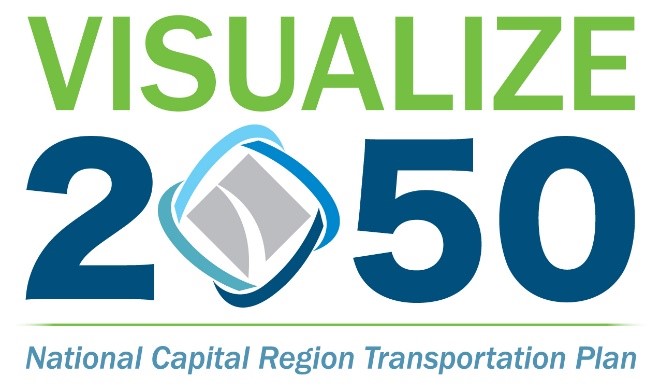Visualize 2050 Comment Period Opens October 23rd
Employers and commuters in the National Capital Region will have an opportunity to provide input into the region’s future transportation network as part of Visualize 2050. As a growing and diverse region, metropolitan Washington needs a transportation system that offers a wide range of ways to get around. Planning for the future includes not just highways and highway improvements but also access to other commuter options such as transit, carpool, vanpool, bicycling, walking, and more.
The National Capital Region Transportation Planning Board (TPB) is holding a 30-day public comment period beginning October 23, 2025, for its draft Visualize 2050 National Capital Region Transportation Plan, the draft FY 2026-2029 Transportation Improvement Program (TIP), and the draft Air Quality Conformity Analysis Report on the draft plan and TIP. The TPB is scheduled to take action on Visualize 2050 at its December 17, 2025 board meeting.
Visualize 2050 is the National Capital Region’s latest version of the federally mandated metropolitan transportation plan which must be updated at least every four years. The long-range plan documents the current state of transportation in the region, priority transportation investments to alleviate transportation challenges and related issues such as congestion, the amount of funding anticipated to be available through the plan’s horizon year 2050, and performance measures and targets to access current and future transportation projects and initiatives.
Visualize 2050 notes the importance of integrating Transportation Demand Management (TDM) strategies as part of a highly functional transportation system. For instance:
- SmartBenefits for transit/vanpool pre-tax or direct cash subsidy benefits. These are the most widely used employer commute benefit programs and according to the Commuter Connections 2022 State of the Commute survey, employee transit use doubles (18% to 36%) when such a benefit is provided by employers that do not offer free parking.
- Collaboration with Commuter Connections (a regional network of 26 transportation entities) has significantly reduced daily vehicle trips by nearly 100,000 and associated vehicle miles traveled by nearly 1.9 million between 2020 and 2023.
- More employers have implemented policies requiring employees to commute to the office for part of the week or all workdays, resulting in a mix of benefits and challenges to both employers and commuting employees.
One of the TPB’s major goals in revising the plan is to “Provide Affordable and Convenient Mobility Options.” What does that mean to employers and commuters within the region? Through the TPB, transportation agencies in the region work together to provide more convenient and affordable transportation options so that each person can choose what works best for them. Research shows that by 2050, the region will grow more than 20 percent in number of residents, households, and employees. With that growth, local land use practices will continue to guide more people and jobs toward the region’s 145 Regional Activity Centers (RACs) and/or to areas within a half mile of High-Capacity Transit (HCT) stations. Expanding a robust world-class multimodal transportation system will be essential to meeting the region’s long-term goals. And that takes continued investment in the system.
Visualize 2050 forecasts improvements in the following transportation modes by 2050:
- Over 1,700 lane miles of Highways and Major Roads will increase by 700 lane miles by 2050.
- Rail Transit Systems, which include 304 rail miles and 144 stations made up of WMATA’s Metrorail, Maryland’s MARC, and Virginia’s VRE, will expand to 322 miles and 171 stations, collectively by 2050.
- The region’s extensive Bus Network, 14 lane miles of bus rapid transit (BRT) and 28 BRT stations, will grow to 93 lane miles and 118 stations by 2050.
- For Walking, Biking, and Micromobility, the region’s 400+ miles of bike lanes will continue to expand through roadway projects that integrate more bicycle facilities.
- Travel Behavior is expected to shift modestly upward by 2050 for modes such as carpooling, walking, biking, and transit, from 59 percent to 62 percent of all trips. The increase will come mostly from growth in walking and biking from 12 to 14 percent.
For these improvements to take root, it will require investment not only in capital improvement but maintenance of these systems. Approximately 85 percent of the expenses tied to transportation improvements are for maintenance. These funds will support critical work like repaving roads, rehabilitating or replacing bridges, and operating and maintaining Metrorail, VRE, MARC, and bus transit services and vehicles. The remaining 15 percent of expenditures will expand the system.
The financial plan for future investments highlights a TPB priority strategy relevant to TDM. The plan projects providing more teleworking and other options for commuting such as vanpool or carpool and alternative work schedules. In addition to continued Commuter Connections funding, the plan notes that many projects promote alternatives to SOV travel; however, no single project alone can be expected to reduce vehicle miles traveled (VMT) in a significant manner at the regional level. It is instead the collection of projects together that make increased use of more sustainable commuting options more feasible.
Another investment relevant to TDM is the expansion of the express highway network, with rapid transit, and allowing carpools and vanpools to ride free. The new facilities will continue to support commuter buses by allowing them to travel for free as well. Efforts such as these help the region achieve reliability and affordability for convenient multimodal options by implementing its priority strategy to expand the express highway network where carpools and vanpools travel toll free and transit use along Express Lanes is encouraged.
The comment period will be open from October 23 through November 21, 2025. Please provide comments to continue your support of the region’s transportation system and the options that are important to you. Your feedback can help confirm that investment in more sustainable travel methods is a robust and forward-thinking piece of Visualize 2050. Visit Visualize2050.org to review the draft Visualize 2050 plan, other key documents, and to participate during the open comment period.

